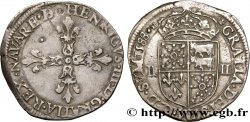v53_0105 - PHENICIA - TRIPOLIS Tétradrachme stéphanophore
MONNAIES 53 (2012)
Prezzo di inizio : 1 800.00 €
Valutazione : 3 200.00 €
Prezzo realizzato : 2 126.00 €
Numero di offerte : 2
Offerta maxima : 2 600.00 €
Prezzo di inizio : 1 800.00 €
Valutazione : 3 200.00 €
Prezzo realizzato : 2 126.00 €
Numero di offerte : 2
Offerta maxima : 2 600.00 €
Tipo : Tétradrachme stéphanophore
Data: an 209
Nome della officina / città: Phénicie, Tripolis
Metallo : argento
Diametro : 28 mm
Asse di coniazione : 1 h.
Peso : 15,26 g.
Grado di rarità : R2
Commenti sullo stato di conservazione:
Exemplaire sur un petit flan centré des deux côtés. Très beaux portraits des Dioscures. Joli revers. Très jolie patine de médaillier à reflets bleutés acier irisés. Le droit a été légèrement nettoyé anciennement
N° nelle opere di riferimento :
Pedigree :
Cet exemplaire provient de la collection de Claude Lainé (les Dioscures, Castor et Pollux et les Jumeaux)
Diritto
Titolatura diritto : ANÉPIGRAPHE.
Descrittivo diritto : Bustes accolés des Dioscures laurés et drapés à droite, surmontés chacun d’une étoile ; le tout entouré de la stemma.
Rovescio
Descrittivo rovescio : Tyché tourelée debout à gauche, vêtue du chiton, tenant un timon de la main droite et une corne d’abondance de la main gauche ; le tout dans une couronne de laurier.
Legenda rovescio : TRIPOLITWN/ THS IERAS KAI// AUTONOMOU/ G/ IH /QS
Traduzione rovescio : (de Tripoli la sainte et autonome).
Commento
Sur ce tétradrachme, la stemma n’est pratiquement pas visible. Mêmes coins que l’exemplaire reproduit dans l’ouvrage d’Edward Cohen, DCA., p. 385, n° 715. Sur cet exemplaire, nous avons une double datation en ère séleucide (an 209) à l’exergue et ère tripolitaine (an 3) dans le champ à gauche qui correspond à l’année 104-103 avant J.-C..
On this tetradrachm, the stemma is practically invisible. Same dies as the example reproduced in the work of Edward Cohen, DCA., p. 385, no. 715. On this example, we have a double dating in the Seleucid era (year 209) in the exergue and Tripolitan era (year 3) in the left field which corresponds to the year 104-103 BC.
On this tetradrachm, the stemma is practically invisible. Same dies as the example reproduced in the work of Edward Cohen, DCA., p. 385, no. 715. On this example, we have a double dating in the Seleucid era (year 209) in the exergue and Tripolitan era (year 3) in the left field which corresponds to the year 104-103 BC.








 Segnalare un errore
Segnalare un errore Stampate la pagina
Stampate la pagina Condividi mia selezione
Condividi mia selezione Fai una domanda
Fai una domanda Consegnare / vendere
Consegnare / vendere






